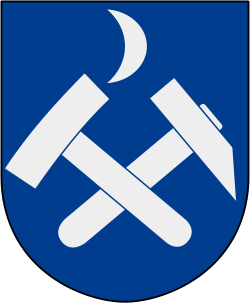Sala, Sweden
Sala is a locality and the seat of Sala Municipality in Västmanland County, Sweden. As of 2010, it has a population of 12,289.[1]
Sala | |
|---|---|
 Coat of arms | |
 Sala  Sala | |
| Coordinates: 59°55′N 16°36′E | |
| Country | Sweden |
| Province | Västmanland |
| County | Västmanland County |
| Municipality | Sala Municipality |
| City status | 1624 |
| Area | |
| • Total | 11.01 km2 (4.25 sq mi) |
| Population (31 December 2010)[1] | |
| • Total | 12,289 |
| • Density | 1,116/km2 (2,890/sq mi) |
| Time zone | UTC+1 (CET) |
| • Summer (DST) | UTC+2 (CEST) |
| Website | www.sala.se |
Sala is the home of several famous places and people, but it is most known for its silver mine (silvergruva), which today is a popular tourist attraction.
Silvergruva
The small town is best known for its historic silver mine (silvergruva), which is located about 2.7 kilometres (1.7 mi) southwest of the town. It dates back to at least Medieval times, and was in operation until 1908. In 1624, the town of Sala was moved to its current location close to the mine, receiving its royal charter from King Gustavus Adolphus.[2]
The silver was important for Sweden's economy and the base for coin production. A total of 400 tonnes of silver was extracted, and 40,000 tonnes of lead; with at most 3-5 tonnes of silver during a year.
The mine eventually reached a depth of 300 metres (980 ft), and a total heading length of 19 km (12 mi).
Amenities

The main street, in terms of retail outlets, is Drottninggatan, to the west of Stora Torget (the town square), and Bergmansgatan, to the east.
The spa town of Sätra brunn, about 14 km (9 mi) from Sala, is another important place for the town.
Transportation
Sala's bus and train station is located on Stationsplan, a short semi-circular road off Väsbygatan. About 35 trains from Stockholm Central Station (either directly or indirectly) arrive at the station each day, with 39 making the return trip. The three high-speed SJ Snabbtåg trips take about one hour and twenty minutes. Journeys on SJ InterCity trains take a similar amount of time and run seven times a day. The slower SJ Regionaltåg trains take just over two hours but make 23 trips from the capital. There is one SJ Tåg i Bergslagen, which departs Stockholm at 22:14 and is direct to Sala.
The SJ trains that pass through terminate at either Stockholm, Linköping, Falun, Mora (once per day), Uppsala or Västerås.
Sport
Sala's football club, Sala FF, play in Division 3 Södra Norrland in Sweden's fifth tier. They were founded in December 1972, when IF Norden and IFK Sala merged.[3] Their former home was Silvervallen, but they now play at the sports fields on Sportfältsgatan.
The first floorball club in the world, Sala IBK, was founded in Sala 1979.[4]
Notable people
The impressionist painter Ivan Aguéli was born in Sala in 1869. There is a small museum and a park dedicated to his memory in the centre of the town. Sala is also the domicile of the former Swedish Minister of Foreign Affairs and former Deputy Prime Minister Lena Hjelm-Wallén. She held several ministerial posts in the Social Democratic government in the 1980s and 1990s and has, despite her career in politics, remained in Sala and is still active in local life.
Ice hockey player Erik Ersberg was born here.
References
- "Tätorternas landareal, folkmängd och invånare per km2 2005 och 2010" (in Swedish). Statistics Sweden. 14 December 2011. Archived from the original on 27 January 2012. Retrieved 10 January 2012.
- "Silver town Sala". sala.se Tourist information. Sala municipality. Retrieved 11 September 2015.
- About - Sala FF
- Innebandyns födelse
External links
External links
![]()